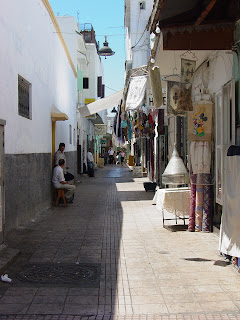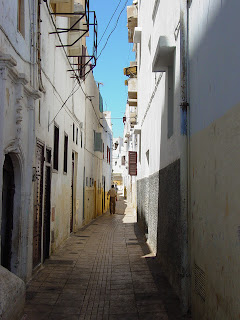 |
| The view of the twin city of Sale across the river mouth as viewed from Rabat's old city. |


I think if I had to pick a favorite capital city in the world, it might be Rabat, in Morocco. It is small and manageable, but central to the country and all the things one might need such as beaches, culture shows, and heritage. The incredible half completed Hassan Mosque (
#864) sits on the top of the river cliff overlooking Sale the equally magnificent old city across the water (the Oued Bou Regreg). But one of the glories of Rabat is the old city which sits majestically on the cliffs above the beach, overlooking all that was important in its trade-packed history where it has risen to importance and fallen into village obscurity. It is not a huge old town, but what it lacks in size it makes up for in pretty alleyways and excellent shopping!


I think one of my favorite memories is from my first visit to the city. I was shopping in the old souq for souvenirs and gifts for Christmas, but it was hot and almost lunchtime, and one by one all the shops closed up for an afternoon siesta. The pretty wooden doors were soon all boarded up and the previously busy street was empty and quiet.

Returning years later when I was visiting Morocco for a friend's wedding, I was impressed that the beautiful sun shades and arches were still there and just as beautiful as I remembered.


The city is painted white and blue and green, but not overly so, and it is kept clean and safe because of both it's small size and the tourists that pass through, but it is local in a way that Fes and Marrakech are touristy.

Rabat has really only been the capital of Morocco since it was part of the French protectorate (away from the intrigues of the traditional capitals of Fes (
#929), Meknes, and Marrakech (
#988), although there were two brief imperial capital periods. However, it has been settled since the 8th century BC, with the necropolis at Chellah, a Phoenician then Roman settlement (called Sala Colonia), evolving into a Berber kingdom (keeping prominence as a settlement long after the Romans were gone, similar to its more northern cousin Volubilis (
#912)). In the 10th century, the Zenata tribe that controlled Sale built a
ribat (fortress-monastery) on the site of the Kasbah, which was later rebuilt by the Almohads in the 12th century. After the successful campaigns against the Spanish Reconquista under Yacoub al-Mansour, Ribat al Fatah (Victory Fortress) was expected to become a great capital, and the extensive walls and Bab Oudaia gate were built, the grand mosque planned, but all came to a halt with Al-Mansour's death in 1199 and the town fell from significance.


In the 17th century there was an injection of new settlers in the area with refugees from Muslim Spain, Christian renegades, Moorish pirates, corsairs and other adventurers, many of whom roamed the Atlantic for Christian slave labor, only partially reined in by the Alawite sultans. The old city has survived from this era, and the modern capital (since 1956 independence) was a recognition of its suitable location, but the old part of the city is definitely smaller than those in Fes, Meknes and Marrakech.


Inside you will find the Souq as-Sebbat with lots of jewelry for sale, and a small flea market near the river. In the days of the Sallee Rovers, the broad open area near the Kasbah was site of the slave auctions.
Source: Lonely Planet Morocco 6th Edition 2003

 Returning years later when I was visiting Morocco for a friend's wedding, I was impressed that the beautiful sun shades and arches were still there and just as beautiful as I remembered.
Returning years later when I was visiting Morocco for a friend's wedding, I was impressed that the beautiful sun shades and arches were still there and just as beautiful as I remembered.  The city is painted white and blue and green, but not overly so, and it is kept clean and safe because of both it's small size and the tourists that pass through, but it is local in a way that Fes and Marrakech are touristy.
The city is painted white and blue and green, but not overly so, and it is kept clean and safe because of both it's small size and the tourists that pass through, but it is local in a way that Fes and Marrakech are touristy. Rabat has really only been the capital of Morocco since it was part of the French protectorate (away from the intrigues of the traditional capitals of Fes (#929), Meknes, and Marrakech (#988), although there were two brief imperial capital periods. However, it has been settled since the 8th century BC, with the necropolis at Chellah, a Phoenician then Roman settlement (called Sala Colonia), evolving into a Berber kingdom (keeping prominence as a settlement long after the Romans were gone, similar to its more northern cousin Volubilis (#912)). In the 10th century, the Zenata tribe that controlled Sale built a ribat (fortress-monastery) on the site of the Kasbah, which was later rebuilt by the Almohads in the 12th century. After the successful campaigns against the Spanish Reconquista under Yacoub al-Mansour, Ribat al Fatah (Victory Fortress) was expected to become a great capital, and the extensive walls and Bab Oudaia gate were built, the grand mosque planned, but all came to a halt with Al-Mansour's death in 1199 and the town fell from significance.
Rabat has really only been the capital of Morocco since it was part of the French protectorate (away from the intrigues of the traditional capitals of Fes (#929), Meknes, and Marrakech (#988), although there were two brief imperial capital periods. However, it has been settled since the 8th century BC, with the necropolis at Chellah, a Phoenician then Roman settlement (called Sala Colonia), evolving into a Berber kingdom (keeping prominence as a settlement long after the Romans were gone, similar to its more northern cousin Volubilis (#912)). In the 10th century, the Zenata tribe that controlled Sale built a ribat (fortress-monastery) on the site of the Kasbah, which was later rebuilt by the Almohads in the 12th century. After the successful campaigns against the Spanish Reconquista under Yacoub al-Mansour, Ribat al Fatah (Victory Fortress) was expected to become a great capital, and the extensive walls and Bab Oudaia gate were built, the grand mosque planned, but all came to a halt with Al-Mansour's death in 1199 and the town fell from significance. 
 In the 17th century there was an injection of new settlers in the area with refugees from Muslim Spain, Christian renegades, Moorish pirates, corsairs and other adventurers, many of whom roamed the Atlantic for Christian slave labor, only partially reined in by the Alawite sultans. The old city has survived from this era, and the modern capital (since 1956 independence) was a recognition of its suitable location, but the old part of the city is definitely smaller than those in Fes, Meknes and Marrakech.
In the 17th century there was an injection of new settlers in the area with refugees from Muslim Spain, Christian renegades, Moorish pirates, corsairs and other adventurers, many of whom roamed the Atlantic for Christian slave labor, only partially reined in by the Alawite sultans. The old city has survived from this era, and the modern capital (since 1956 independence) was a recognition of its suitable location, but the old part of the city is definitely smaller than those in Fes, Meknes and Marrakech.
 Inside you will find the Souq as-Sebbat with lots of jewelry for sale, and a small flea market near the river. In the days of the Sallee Rovers, the broad open area near the Kasbah was site of the slave auctions.
Inside you will find the Souq as-Sebbat with lots of jewelry for sale, and a small flea market near the river. In the days of the Sallee Rovers, the broad open area near the Kasbah was site of the slave auctions. 





No comments:
Post a Comment